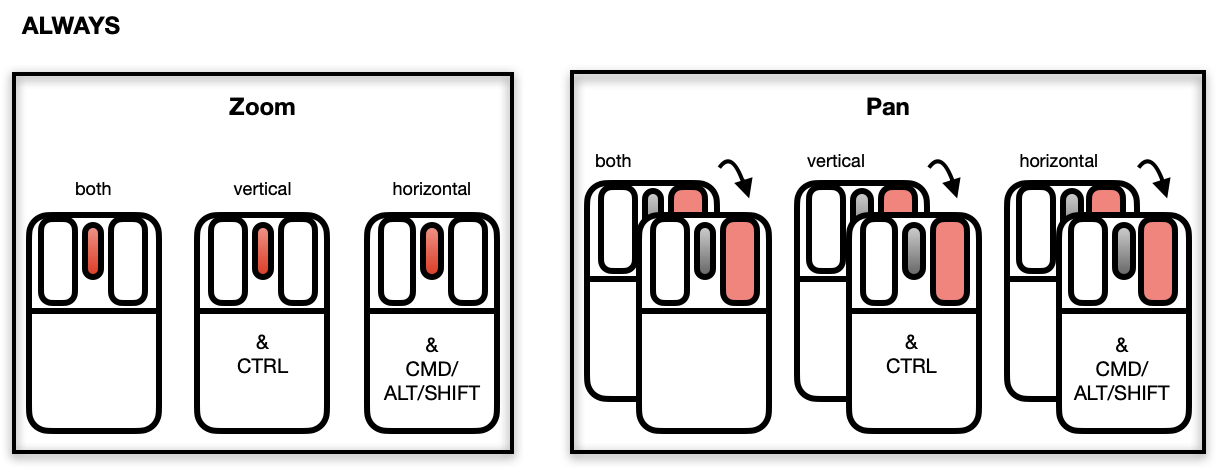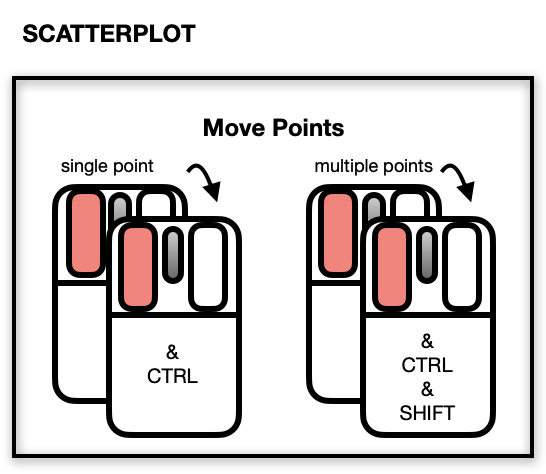Create an interactive loon plot widget
Source:R/l_plot.R, R/l_plot_decomposed_ts.R, R/l_plot_density.R, and 2 more
l_plot.Rdl_plot is a generic function for creating an interactive
visualization environments for R objects.
l_plot(x, y, ...) # S3 method for default l_plot( x, y = NULL, by = NULL, on, layout = c("grid", "wrap", "separate"), connectedScales = c("cross", "row", "column", "both", "x", "y", "none"), color = l_getOption("color"), glyph = l_getOption("glyph"), size = l_getOption("size"), active = TRUE, selected = FALSE, xlabel, ylabel, title, showLabels = TRUE, showScales = FALSE, showGuides = TRUE, guidelines = l_getOption("guidelines"), guidesBackground = l_getOption("guidesBackground"), foreground = l_getOption("foreground"), background = l_getOption("background"), parent = NULL, ... ) # S3 method for decomposed.ts l_plot( x, y = NULL, xlabel = NULL, ylabel = NULL, title = NULL, tk_title = NULL, color = l_getOption("color"), size = l_getOption("size"), linecolor = l_getOption("color"), linewidth = l_getOption("linewidth"), linkingGroup, showScales = TRUE, showGuides = TRUE, showLabels = TRUE, ... ) # S3 method for density l_plot( x, y = NULL, xlabel = NULL, ylabel = NULL, title = NULL, linewidth = l_getOption("linewidth"), linecolor = l_getOption("color"), ... ) # S3 method for map l_plot(x, y = NULL, ...) # S3 method for stl l_plot( x, y = NULL, xlabel = NULL, ylabel = NULL, title = NULL, tk_title = NULL, color = l_getOption("color"), size = l_getOption("size"), linecolor = l_getOption("color"), linewidth = l_getOption("linewidth"), linkingGroup, showScales = TRUE, showGuides = TRUE, showLabels = TRUE, ... )
Arguments
| x | the coordinates of points in the |
|---|---|
| y | the y coordinates of points in the |
| ... | named arguments to modify plot states. See |
| by | loon plot can be separated by some variables into multiple panels.
This argument can take a |
| on | if the |
| layout | layout facets as |
| connectedScales | Determines how the scales of the facets are to be connected depending
on which
|
| color | colours of points; colours are repeated
until matching the number points. Default is found using |
| glyph | the visual representation of the point. Argument values can be any of
|
| size | size of the symbol (roughly in terms of area).
Default is found using |
| active | a logical determining whether points appear or not
(default is |
| selected | a logical determining whether points appear selected at first
(default is |
| xlabel | Label for the horizontal (x) axis. If missing,
one will be inferred from |
| ylabel | Label for the vertical (y) axis. If missing,
one will be inferred from |
| title | Title for the plot, default is an empty string. |
| showLabels | logical to determine whether axes label (and title) should be presented. |
| showScales | logical to determine whether numerical scales should be presented on both axes. |
| showGuides | logical to determine whether to present background guidelines to help determine locations. |
| guidelines | colour of the guidelines shown when |
| guidesBackground | colour of the background to the guidelines shown when
|
| foreground | foreground colour used by all other drawing.
Default is found using |
| background | background colour used for the plot.
Default is found using |
| parent | a valid Tk parent widget path. When the parent widget is
specified (i.e. not |
| tk_title | provides an alternative window name to Tk's |
| linecolor | line colour of all time series.
Default given by |
| linewidth | line width of all time series (incl. original and decomposed components.
Default given by |
| linkingGroup | string giving the linkingGroup for all plots. If missing,
a default |
Value
The input is a
stlor adecomposed.tsobject, a structure of class"l_ts"containing four loon plots each representing a part of the decomposition by name: "original", "trend", "seasonal", and "remainder"The input is a vector, formula, data.frame, ...
by = NULL: aloonwidget will be returnedbyis notNULL: anl_facetobject (a list) will be returned and each element is aloonwidget displaying a subset of interest.
Details
Like plot in R, l_plot is
the generic plotting function for objects in loon.
The default method l_plot.default produces the interactive
scatterplot in loon.
This is the workhorse of `loon` and is often a key part of many
other displays (e.g. l_pairs and l_navgraph).
For example, the methods include l_plot.default (the basic interactive scatterplot),
l_plot.density (layers output of density in an empty scatterplot),
l_plot.map (layers a map in an empty scatterplot), and
l_plot.stl (a compound display of the output of stl).
A complete list is had from methods(l_plot).
vignette(topic = "introduction", package = "loon")
and to explore loon's website accessible via l_help(). The general direct manipulation and interaction gestures are outlined in the following figures.
Zooming and Panning

Selecting Points/Objects

Moving Points on the Scatterplot Display

The scatterplot displays a number of direct interactions with the
mouse and keyboard, these include: zooming towards the mouse cursor using
the mouse wheel, panning by right-click dragging and various selection
methods using the left mouse button such as sweeping, brushing and
individual point selection. See the documentation for l_plot
for more details about the interaction gestures.
Some arguments to modify layouts can be passed through,
e.g. "separate", "ncol", "nrow", etc. Check l_facet
to see how these arguments work.
See also
Turn interactive loon plot static loonGrob, grid.loon, plot.loon.
Density layer l_layer.density
Map layer l_layer, l_layer.map,
map
Other loon interactive states:
l_hist(),
l_info_states(),
l_serialaxes(),
l_state_names(),
names.loon()
Examples
if(interactive()) { ########################## l_plot.default ########################## # default use as scatterplot p1 <- with(iris, l_plot(Sepal.Length, Sepal.Width, color=Species, title = "First plot")) # The names of the info states that can be # accessed or set. They can also be given values as # arguments to l_plot.default() names(p1) p1["size"] <- 10 p2 <- with(iris, l_plot(Petal.Length ~ Petal.Width, linkingGroup="iris_data", title = "Second plot", showGuides = FALSE)) p2["showScales"] <- TRUE # link first plot with the second plot requires # l_configure to coordinate the synchroniztion l_configure(p1, linkingGroup = "iris_data", sync = "push") p1['selected'] <- iris$Species == "versicolor" p2["glyph"][p1['selected']] <- "cdiamond" gridExtra::grid.arrange(loonGrob(p1), loonGrob(p2), nrow = 1) # Layout facets ### facet wrap p3 <- with(mtcars, l_plot(wt, mpg, by = cyl, layout = "wrap")) # it is equivalent to # p3 <- l_plot(mpg~wt, by = ~cyl, layout = "wrap", on = mtcars) ### facet grid p4 <- l_plot(x = 1:6, y = 1:6, by = size ~ color, size = c(rep(50, 2), rep(25, 2), rep(50, 2)), color = c(rep("red", 3), rep("green", 3))) # Use with other tk widgets tt <- tktoplevel() tktitle(tt) <- "Loon plots with custom layout" p1 <- l_plot(parent=tt, x=c(1,2,3), y=c(3,2,1)) p2 <- l_plot(parent=tt, x=c(4,3,1), y=c(6,8,4)) tkgrid(p1, row=0, column=0, sticky="nesw") tkgrid(p2, row=0, column=1, sticky="nesw") tkgrid.columnconfigure(tt, 0, weight=1) tkgrid.columnconfigure(tt, 1, weight=1) tkgrid.rowconfigure(tt, 0, weight=1) ########################## l_plot.decomposed.ts ########################## decompose <- decompose(co2) p <- l_plot(decompose, title = "Atmospheric carbon dioxide over Mauna Loa") # names of plots in the display names(p) # names of states associated with the seasonality plot names(p$seasonal) # which can be set p$seasonal['color'] <- "steelblue" ########################## l_plot.stl ########################## co2_stl <- stl(co2, "per") p <- l_plot(co2_stl, title = "Atmospheric carbon dioxide over Mauna Loa") # names of plots in the display names(p) # names of states associated with the seasonality plot names(p$seasonal) # which can be set p$seasonal['color'] <- "steelblue" ########################## l_plot.density ########################## # plot a density estimate set.seed(314159) ds <- density(rnorm(1000)) p <- l_plot(ds, title = "density estimate", xlabel = "x", ylabel = "density", showScales = TRUE) ########################## l_plot.map ########################## if (requireNamespace("maps", quietly = TRUE)) { p <- l_plot(maps::map('world', fill=TRUE, plot=FALSE)) } }